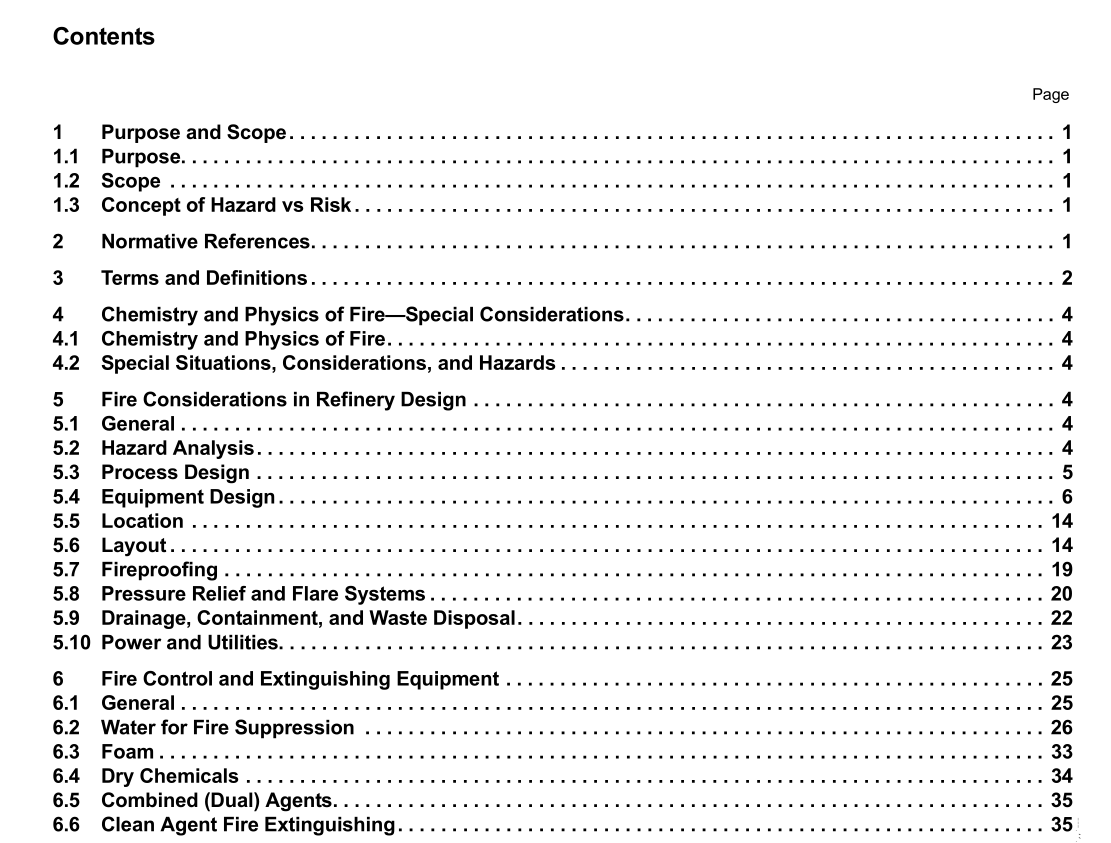API RP 2001 pdf download

API RP 2001 pdf download.Fire Protection in Refineries
1 Purpose and Scope
1.1 Purpose The purpose of this recommended practice is to provide a better understanding of refinery fire protection and the steps needed to promote the safe storage, handling, and processing of petroleum and petroleum products in refineries. A basic premise of this standard is that fire prevention provides the fundamental foundation for fire protection. 1.2 Scope This document covers basic concepts of refinery fire prevention and protection. It reviews the chemistry and physics of refinery fires; discusses how the design of refinery systems and infrastructure impact the probability and consequences of potential fires; describes fire control and extinguishing systems typically used in refineries; examines fire protection concepts that should be covered in operating and maintenance practices and procedures; and provides information on organization of and training for refinery emergency responders. Many of the concepts, systems, and equipment discussed in this document are covered in detail in referenced publications, standards, or governmental requirements. 1.3 Concept of Hazard vs Risk Hazards are situations or properties of materials with the inherent ability to cause harm. Flammability, toxicity, corrosivity, and stored electrical, chemical, or mechanical energy all are hazards associated with various industrial materials or situations. Risk requires exposure. A hot surface or material can cause thermal skin burns or a corrosive acid can cause chemical skin burns, but these can occur only if there is contact exposure to skin. A person working at an elevated height has “stored energy” and a fall from a height can cause injury—but there is no risk unless a person is indeed working at heights and thus exposed to the hazard. There is no risk when there is no potential for exposure.
3 Terms and Definitions
For the purposes of this document, the following definitions apply. Additional definitions and an expanded discussion of fire-related hydrocarbon properties and phenomena are included in Section 4 and Annex A. 3.1 clean agent Electrically nonconducting volatile or gaseous fire suppression agent approved by the U.S. Environmental Protection Agency (EPA) as substitutes for chemicals judged by EPA to be ozone depleting and are being phased out under provisions of the Clean Air Act (CAA); clean agents do not leave a residue upon evaporation. 3.2 combustible As defined by NFPA and used in this document, refers to any solid that can burn or to any liquid that has a flash point of 100 °F (37.8 °C) or greater. See NFPA 30 for subclassification of combustible liquids. 3.3 combustion (burning) The rapid reaction of oxidizable material with an oxidizer, usually oxygen from the air, followed by the development of heat. This reaction usually produces flames. 3.4 dry chemical agent A powder of very small particles (usually sodium bicarbonate, potassium bicarbonate, or ammonium phosphate) treated for proper flow capabilities and tailored for Class A (combustible), Class B (flammable), or Class C (electrical) fires (see NFPA 17 for specifics). 3.5 fire hazard analysis FHA A study used to evaluate fire hazards in a specific potential fire area and evaluate consequences of fire-related events. 3.6 flammable As defined by NFPA and used in this document, refers to any gas that can burn or to any liquid that has a flash point below 100 °F (37.8 °C). The archaic term inflammable is obsolete. See NFPA 30 for subclassification of flammable liquids.3.7 foam For fire protection purposes is an aggregate of air-filled bubbles that will float on the surface of a flammable liquid. They are aerated solutions of water and a proper proportion of foam concentrate that may include a film forming agent. 3.8 fuel Material capable of undergoing combustion. It is the material that burns to feed a fire. 3.9 furnace “stuffing” A furnace or heater running in a fuel-rich condition. 3.10 hazard A situation or inherent chemical or physical property with the potential to do harm (flammability, oxygen deficiency, toxicity, corrosivity, and stored electrical, chemical, or mechanical energy). 3.11 management of change MOC A process to identify, evaluate, and address needs associated with changes in process technology, equipment. materials, or procedures other than “replacement in kind.” Some facilities apply MOC principles to personnel and organizations.









